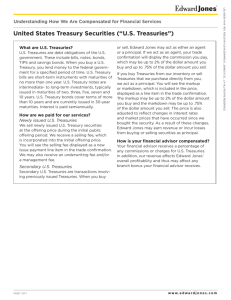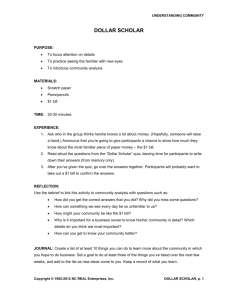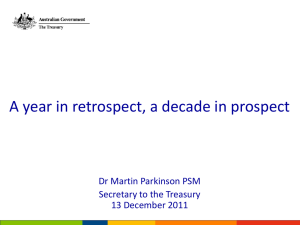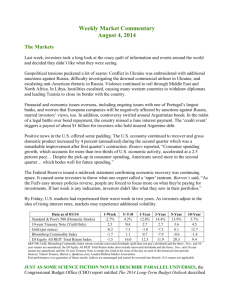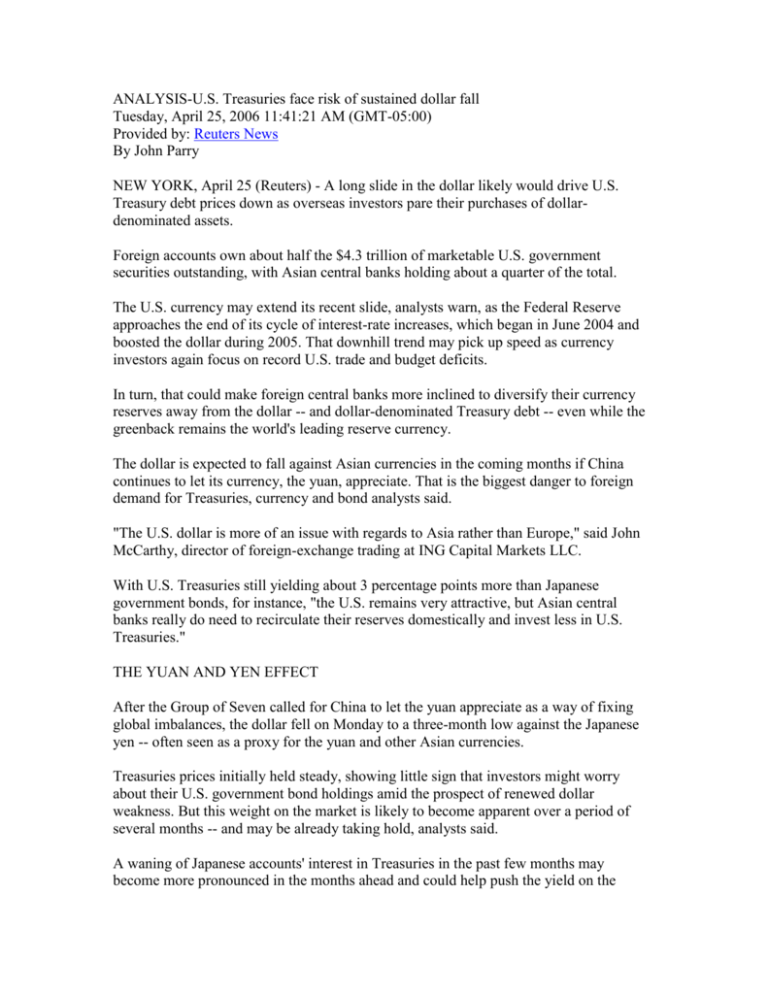
ANALYSIS-U.S. Treasuries face risk of sustained dollar fall
Tuesday, April 25, 2006 11:41:21 AM (GMT-05:00)
Provided by: Reuters News
By John Parry
NEW YORK, April 25 (Reuters) - A long slide in the dollar likely would drive U.S.
Treasury debt prices down as overseas investors pare their purchases of dollardenominated assets.
Foreign accounts own about half the $4.3 trillion of marketable U.S. government
securities outstanding, with Asian central banks holding about a quarter of the total.
The U.S. currency may extend its recent slide, analysts warn, as the Federal Reserve
approaches the end of its cycle of interest-rate increases, which began in June 2004 and
boosted the dollar during 2005. That downhill trend may pick up speed as currency
investors again focus on record U.S. trade and budget deficits.
In turn, that could make foreign central banks more inclined to diversify their currency
reserves away from the dollar -- and dollar-denominated Treasury debt -- even while the
greenback remains the world's leading reserve currency.
The dollar is expected to fall against Asian currencies in the coming months if China
continues to let its currency, the yuan, appreciate. That is the biggest danger to foreign
demand for Treasuries, currency and bond analysts said.
"The U.S. dollar is more of an issue with regards to Asia rather than Europe," said John
McCarthy, director of foreign-exchange trading at ING Capital Markets LLC.
With U.S. Treasuries still yielding about 3 percentage points more than Japanese
government bonds, for instance, "the U.S. remains very attractive, but Asian central
banks really do need to recirculate their reserves domestically and invest less in U.S.
Treasuries."
THE YUAN AND YEN EFFECT
After the Group of Seven called for China to let the yuan appreciate as a way of fixing
global imbalances, the dollar fell on Monday to a three-month low against the Japanese
yen -- often seen as a proxy for the yuan and other Asian currencies.
Treasuries prices initially held steady, showing little sign that investors might worry
about their U.S. government bond holdings amid the prospect of renewed dollar
weakness. But this weight on the market is likely to become apparent over a period of
several months -- and may be already taking hold, analysts said.
A waning of Japanese accounts' interest in Treasuries in the past few months may
become more pronounced in the months ahead and could help push the yield on the
benchmark 10-year U.S. Treasury note <US10YT=RR> up to about 5.25 percent, said
Kevin Flanagan, fixed-income strategist for global wealth management with Morgan
Stanley in Purchase, New York.
The 10-year Treasury note's yield rose to 5.08 percent at midday on Tuesday in New
York, from 4.99 percent late Monday. The 10-year note's price, which moves in the
opposite direction of its yield, was down 22/32.
Dollar weakness, especially against the yen <JPY=>, and the Bank of Japan's paving the
way to raise interest rates are both factors crimping Japanese demand for U.S.
government debt and weighing on Treasury prices, Flanagan said.
That said, there is underlying demand for some dollar-denominated securities from
Japan. Some of the country's top life insurers told Reuters in a series of interviews that
they view any drop in the dollar below 110 yen as a good moment to buy U.S. bonds.
APPETITE FOR SHORT-TERM DEBT
Short-dated Treasuries may fare better than longer maturities during a dollar drop,
analysts expect. As Asian central banks try to mitigate a competitive threat to their
exporters by preventing their currencies from appreciating too sharply, they would make
dollar purchases, which central banks tend to concentrate in shorter maturities.
"If what we are going to see with the dollar weakening is central banks' possibly buying
the dollar to try to counteract the pace of the deterioration ... I think you will see central
banks more active at the front end of the curve, and we will see a steepening of the yield
curve," said Ward McCarthy, managing director of Stone & McCarthy Research in
Princeton, New Jersey.
The "yield curve" gap of the 10-year Treasury note's yield above the 2-year note's yield
was about 13 basis points on Tuesday.
Based on current trends, McCarthy expects net foreign purchases of Treasury debt to
shrink to about $21 billion per month this year, down from about $30 billion in 2005.
"That is a pretty sharp slowdown," he said. Most of the drop in demand will be for
longer maturities, pushing up their yields more than those of shorter maturities, he said.
U.S. accounts probably will keep buying Treasuries, which yield more than euro zone
and Japanese government bonds, even in the face of a slipping dollar, analysts said.
"In terms of our view of the dollar, which is pretty much a longer-term negative, we
continue to favor international equities," said Dan Peirce, a portfolio manager on the
global asset allocation team of State Street Global Advisors in Boston. However, "there
is no huge incentive for U.S. investors to go into non-U.S. fixed income where you
concede valuation to go overseas."
On Tuesday, the 10-year Japanese government bond was yielding around 1.92 percent,
compared with the euro zone 10-year German bund at around 4.00 percent.
((Reporting by John Parry; Editing by Jan Paschal;
Reuters Messaging:
rm:// john.parry.reuters.com@reuters.net;
E-mail: john.parry@reuters.com; Tel: +1 646 223 6303))
(C) Reuters 2006. All rights reserved. Republication or redistribution of Reuters content,
including by caching, framing or similar means, is expressly prohibited without the prior
written consent of Reuters. Reuters and the Reuters sphere logo are registered
trademarks and trademarks of the Reuters group of companies around the world.
nN2546097
US/ US/N

